16 April 2025
 )
)I've recently got interested in West Horsley Place (see photo above). It's a most fascinating stately home in Surrey, not far from London. If you have watched the BBC TV series "Ghosts" you will recognise the house immediately - the show is filmed there on location. And on looking through the website, I found that some of what happens in "Ghosts" is based on what really happened in West Horsley Place.
In "Ghosts" a penniless young woman, Alison Cooper (Charlotte Ritchie) and her partner Mike (Kiell Smith-Bynoe) unexpectedly inherit a huge, crumbling historic house from Alison's great-aunt who is in her 90s. The house needs a fortune in repairs but Alison and Mike decide to try and make it pay for itself. It is some time before they realise that it is haunted by ghosts from several centuries .....
In real life the house was left to TV personality Bamber Gascoigne by his 99 year old aunt, to his total amazement. He then discovered it needed a fortune in repairs, but he decided to try and make it pay for itself..... In his case, he gave it to a trust for free and helped them establish it as an arts and events venue. It will be a long time before it is earning its own keep, but it is on its way. And so far nobody has seen any ghosts there, (but there again - they may be laying low like the ones in the TV show - maybe?
In fact, West Horsley Place has some interesting events going on. I particularly liked reading about Grange Opera, which not only gives public performances but works with children and prisoners too: read more here.
Anyway.... (to get to the point of this post) they are staging "Alice Through the Looking Glass" next 3rd August, gates open at 1 PM. Here's the link.
15 March 2025
I am considering going to Texas next Spring to see the Alice in Wonderland exhibition at the Harry Ransom Center. It's a long way to go but I'd love the chance to see some of their amazing collection of Carrolliana too - letters, manuscripts, rare books. The Center has enough to keep me there for a month! This video gives some background to their wonderful show which will be aimed at all the family.
The same sadly cannot be said about the latest offering from Robert Douglas Fairhurst and Martha Kearney of "Secret World of Lewis Carroll" fame. Now, the talk they will be giving in London to publicise RDF's "celebration of Alice" promises "child prostitutes.""
Like the gnat says in the "Looking Glass" railway carriage "I could make a joke about that," and perhaps the only thing to do is laugh ... or else you would cry.
.jpg)
The same sadly cannot be said about the latest offering from Robert Douglas Fairhurst and Martha Kearney of "Secret World of Lewis Carroll" fame. Now, the talk they will be giving in London to publicise RDF's "celebration of Alice" promises "child prostitutes.""
Like the gnat says in the "Looking Glass" railway carriage "I could make a joke about that," and perhaps the only thing to do is laugh ... or else you would cry.
.jpg)
22 February 2025
I wrote about the sad death of Edward Wakeling here and I thought I'd offer you a little update. When Edward realised how ill he was, he planned with great care what would happen to his amazing research collection after his death. He told me that he planned to leave it to the Surrey History Centre which already has a large collection of Carrolliana. The reason for this is that the family home for the latter part of Lewis Carroll's life was in Guildford, Surrey, where he died in 1898. All of his sisters and one of his brothers outlived him, and the county built up quite a collection of donated items in the early 20th century. The Guildford Museum has a charming collection of personal items relating to Carroll and Alice, and it is well worth visiting.
As it happens, there has been a spate of important Carrollian donations this year. Members of the Dodgson family have decided to release many previously unseen personal items, which are currently being prepared for a special exhibition at the history centre. But I was concerned that it doesn't seem that the county can accept all the objects in Edward's collection. Probate is not complete, but it would not be surprising if small local organisations did not have the resources (or even the mandate) to care for collections of international importance. I can't deny I'm a little concerned, but I have asked Surrey History Centre to keep me informed, and hope to get more information which I'll pass on.
Christ Church college in Oxford has also recently received a hugely valuable and generous bequest from Jon Lindseth, a major American collector of Alice related items. I was invited to this event to commemorate it, but unfortunately I was unable to go. But the exhibition is on until the 17th April and I hope to be able to go and see it, although this coming month is a busy one for me.
Meanwhile, I found this little picture the other day of the large Alice and Cheshire Cat which would indicate to Edward's visitors that they were arriving at his remote country cottage, which was situated on a really tiny little lane in Herefordshire. Just looking at it makes me feel nostalgic!
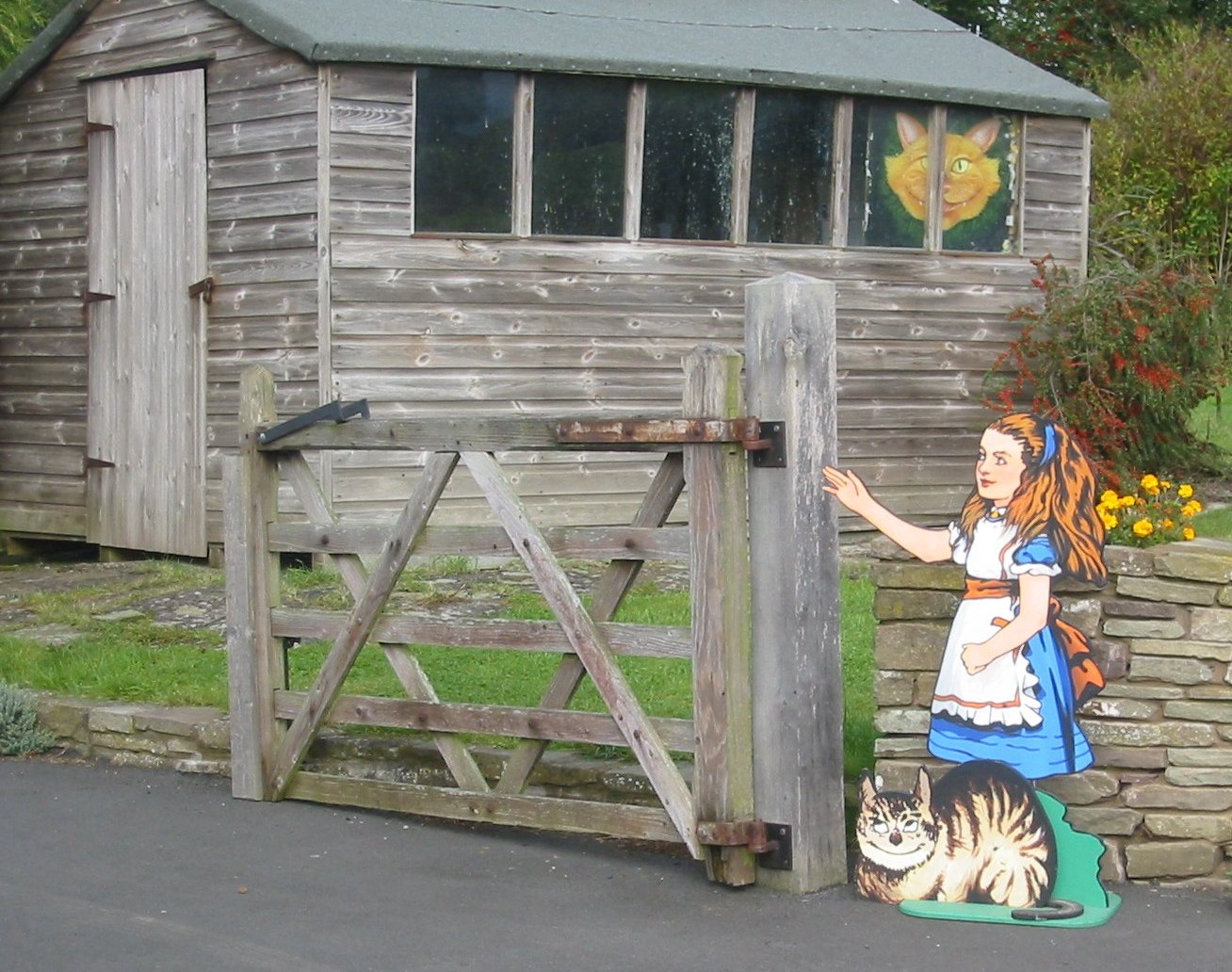
As it happens, there has been a spate of important Carrollian donations this year. Members of the Dodgson family have decided to release many previously unseen personal items, which are currently being prepared for a special exhibition at the history centre. But I was concerned that it doesn't seem that the county can accept all the objects in Edward's collection. Probate is not complete, but it would not be surprising if small local organisations did not have the resources (or even the mandate) to care for collections of international importance. I can't deny I'm a little concerned, but I have asked Surrey History Centre to keep me informed, and hope to get more information which I'll pass on.
Christ Church college in Oxford has also recently received a hugely valuable and generous bequest from Jon Lindseth, a major American collector of Alice related items. I was invited to this event to commemorate it, but unfortunately I was unable to go. But the exhibition is on until the 17th April and I hope to be able to go and see it, although this coming month is a busy one for me.
Meanwhile, I found this little picture the other day of the large Alice and Cheshire Cat which would indicate to Edward's visitors that they were arriving at his remote country cottage, which was situated on a really tiny little lane in Herefordshire. Just looking at it makes me feel nostalgic!

19 March 2024
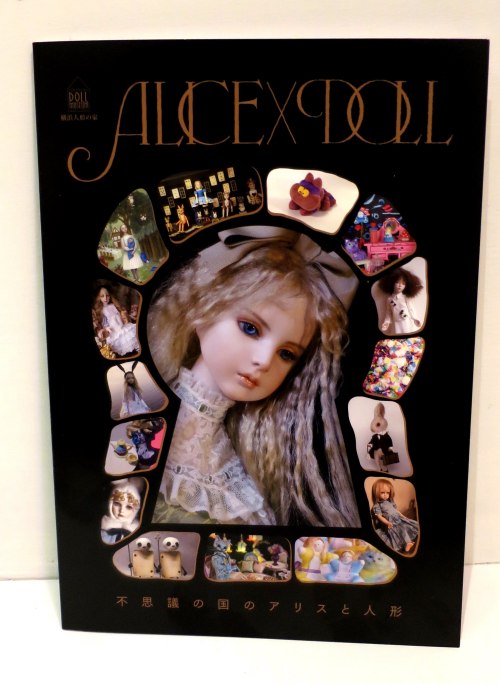
I am very grateful to my friend Yoshi, who as sent me a beautiful catalogue from an exhibition on Alice from the doll museum in Yokohama. I wish I could share all the images and ideas in the catalogue with you.... but sadly, of course, I can't. So here are some things which particularly caught my eye...
"Alice" became a popular subject for translations in the Meiji period, almost as soon as Japan opened up to the West after centuries of isolation. And that was only just after Lewis Carroll published "Wonderland" and before he had published "Looking Glass." In a few short years "Alice in Wonderland" had become the most popular children's book in England, and the Japanese wanted to know about it becase they were learning as much as they could about all aspects of Western culture. And since Japanese interest in such things as movable character dolls were growing fast at the same time, "Alice" was an obvious choice for a Western style doll.. or even a Japanese style one.
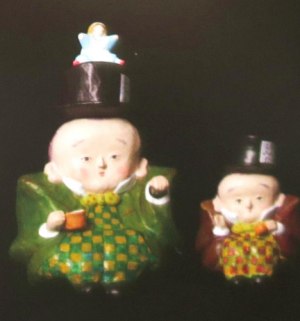
Several of the artists whose work is shown feel strongly about the character of Alice, and identify with it in some way. For instance, Mari Shimazu is inspired by Alice's struggle against Victorian restrictions and also by what she sees as her strong yet gentle and rather melancholy soul. Her dolls are part of a larger body of work around a shadowy 19th century twilight world.
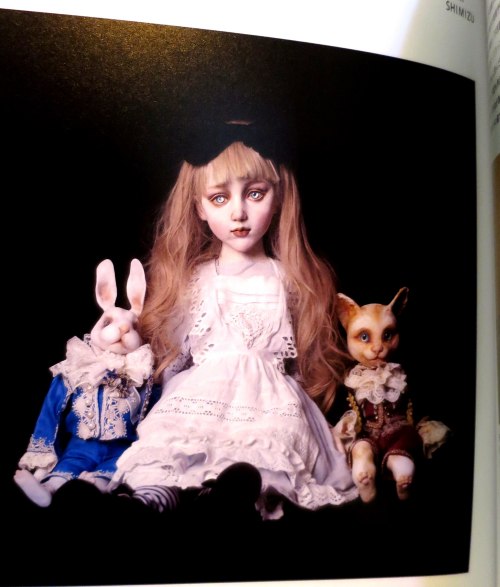
By contrast, Sebastian Masuda is interested in the brightness and colour of youthful excitement which he senses in Alice. Below is a picture of his White Rabbit. When I was young I also felt excited and interested by Alice, never knowing what was around every corner but feeling that it might be something bright and wonderful. So I like his bright and cheerful pictures very much.
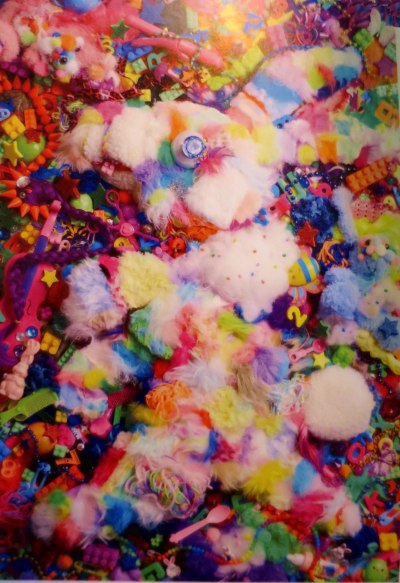
The artist Moyan isn't primarily interested in Alice as a personality. She's far more intrigued by the dreamlike unreality of Alice's surroundings, and likes the idea that nothing is ever in proportion or natural, as you see here.
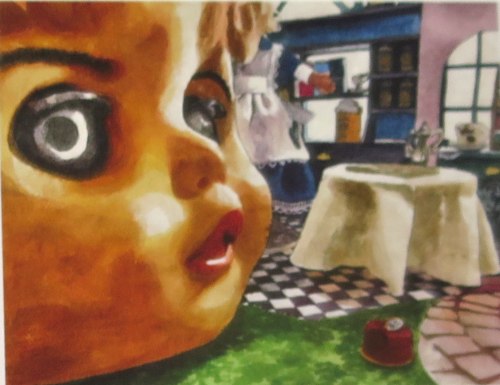
Of course making a doll is not just about having an idea; dollmaking is also a craft, and this is Bibary Maida's main interest. The processes of using certain traditional Japanese papier mache techniques and ideas, help her to enter Alice's world in order to have fun. This is an approach which resonates with me too, because if I'm honest I don't like analysing Alice's feelings very much. I believe that "Alice" is in some ways like a Rorschach test, in which the subject's reaction to abstract ink blots is analysed according to psychological theory. I think we mostly interpret "Alice" to suit our own ideas and state of mind! Bibary Maida says something like this when she mentions that she sees herself looking at her from every one of the dolls she makes.
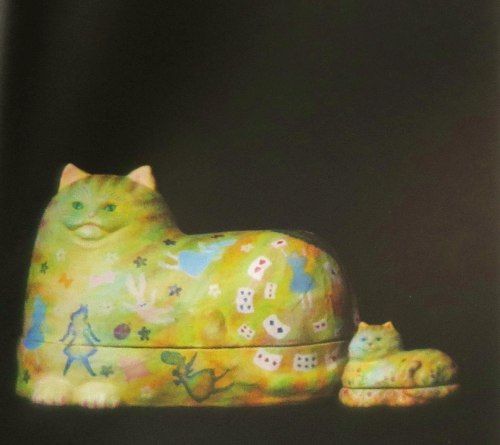
What an interesting exhibition! If I ever return to Japan I'll be sure to visit the Yokohama Doll Museum.
03 December 2023
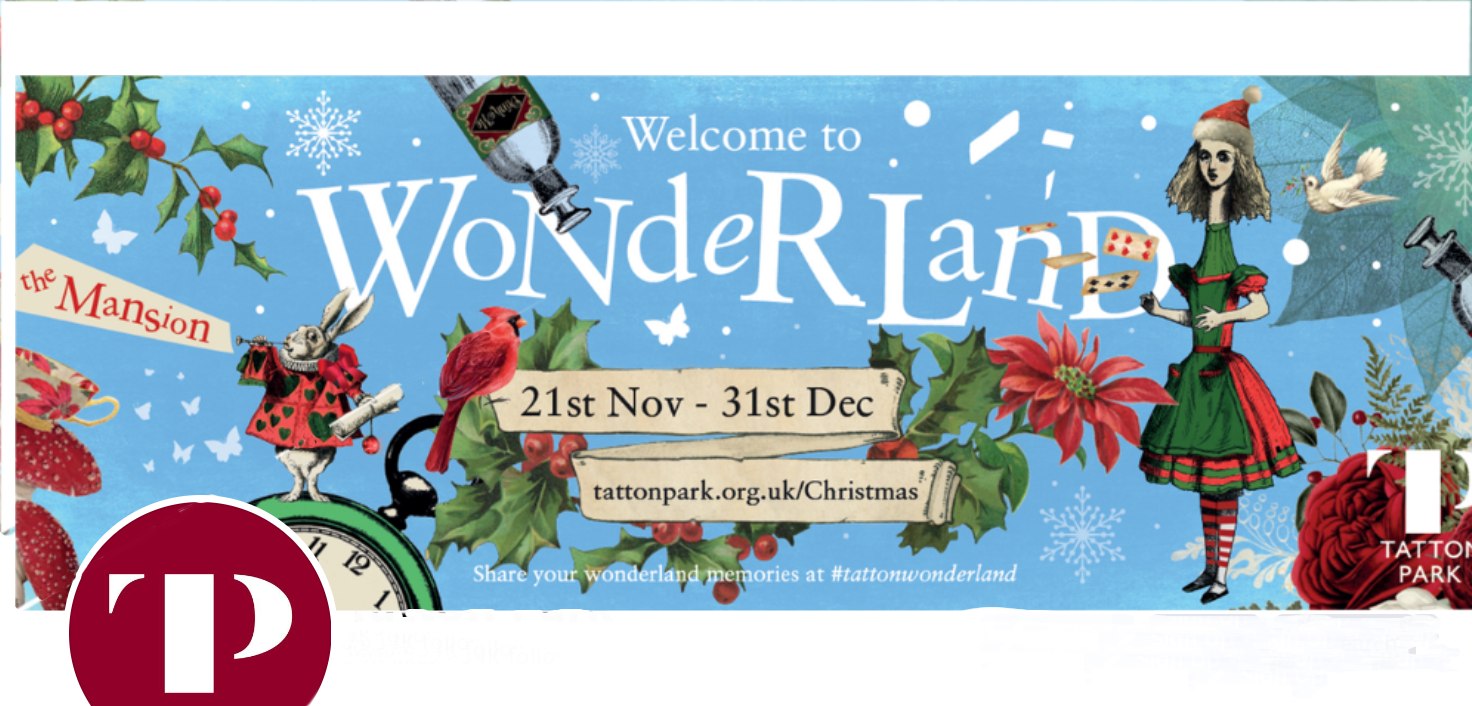
Tatton Park, a grand National Trust house in Cheshire, has an Alice in Wonderland event this Christmas. More details here.
They're rather fond of Alice at Tatton Park. I remember going to a Queen of Hearts Tea there once in the summer, so keep an eye on their website if you're going to be in the area.
15 November 2023
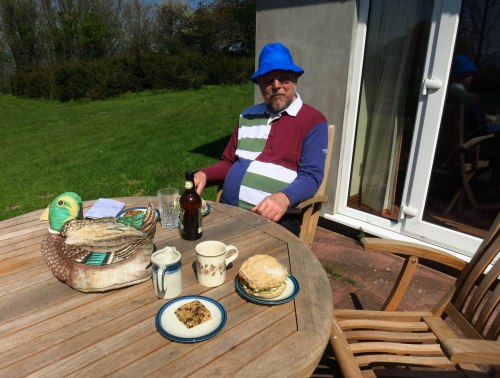
I haven't written here for a while, but I really must put something now because I wanted to write a small appreciation of Edward Wakeling, who was undoubtedly THE world expert on Lewis Carroll. He was such a towering figure that it is almost impossible to believe he has passed away. As well as maintaining a gigantic database, writing tirelessly and looking after a wonderful collection of Carrollania, he was such a nice person - and that is the aspect that I'd mainly like to write about here.
First though, I must mention some of his most useful and remarkable books and pamphlets, which covered most aspects of Carroll's life. His magnum opus was the complete edited edition of the surviving Diaries of Lewis Carroll, meticulously researched and invaluable to any scholar of Carroll and his life. He was also an expert on Lewis Carroll's photography, and compiled the Catalogue Raisonne of Carroll's photographs (here). One of his lesser known but very entertaining books was a look at Lewis Carroll's games and puzzles.
The last of his books which I read was, I believe, the last he ever wrote. It is called THE LIFE OF EDWIN DODGSON, and it was written in conjunction with Caroline Luke, great-granddaughter of Skeffington Dodgson. Based on previously-unpublished material, It tells the life story of the youngest of the Dodgson sons, Edwin, who lived an hard and extraordinary life in various far flung corners of the globe, notably the remote island of Tristan da Cunha. The LCSNA ran a seminar about this book in 2021, which is online at time of writing, here.
On a personal level, whenever I was researching books, media appearances, lectures and newspaper pieces about Carroll, Edward was ready to help if needed. Several times he opened his home to me, let me stay and gave me access to his collections and archives for days at a time. I loved the calm, unchanging atmosphere in his house, particularly his living room with the painted harpsichord, the grand piano and, usually, classical music playing on the radio. I chose the picture above to illustrate him because that informal lunchtime in the garden just sums up what it felt like to be with him in his well tended and utterly fascinating cottage. But I could also mention meals at the pub in Hay, or tea and cake in his conservatory of an afternoon, perhaps with Smokey the cat in attendance. All would have conveyed the orderly, friendly scene that always awaited visitors at his home.
He was welcoming to his friends' families too. We last dropped in to see him in May 2022, when we were on holiday about 30 miles away. He was already feeling great physical limitations, and had suffered many unpleasant medical incidents, but despite this he was his usual self. So we remember that last visit with great affection and happiness, and when we left, we did hope we would see him again.
Sadly, it was not to be. When Christmas comes this year I will really miss receiving his latest instalment of ADVENTURES IN BOOK COLLECTING; his serialised account of hunting down some of his favourite books. Last Christmas he said he still had three more booklets to go, which he hoped to live long enough to send out. We are far from being the only ones who will sincerely mourn the fact that he will not be able to do this. But we know that his memory will be celebrated for as long as people study the life of Charles Dodgson. R.I.P, Edward.
31 October 2021
Nicolas Codron is a French paper artist, making artist's books and pop-ups, with objets in many collections, including the Met in New York. He's very interested in Alice. I was taken by this image of the White Rabbit's watch, with what seems to be a shadow of the White Rabbit racing across it. Some of his Alice items are included in his current exhibition in Paris, at Chantrelivre bookstore.
See what you think of his miniature "Alice " book over on Instagram, with echoes of the original binding which Lewis Carroll chose himself.
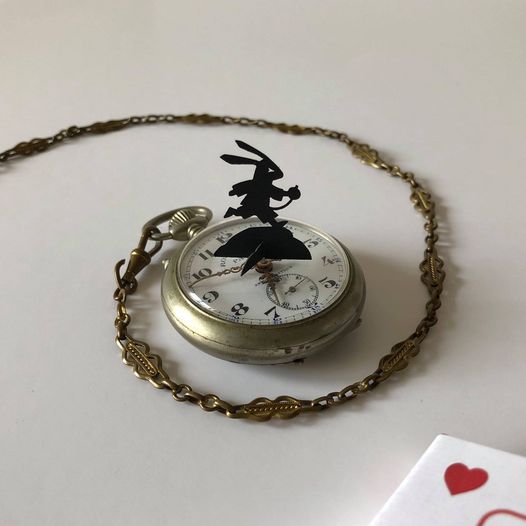
See what you think of his miniature "Alice " book over on Instagram, with echoes of the original binding which Lewis Carroll chose himself.

04 September 2021
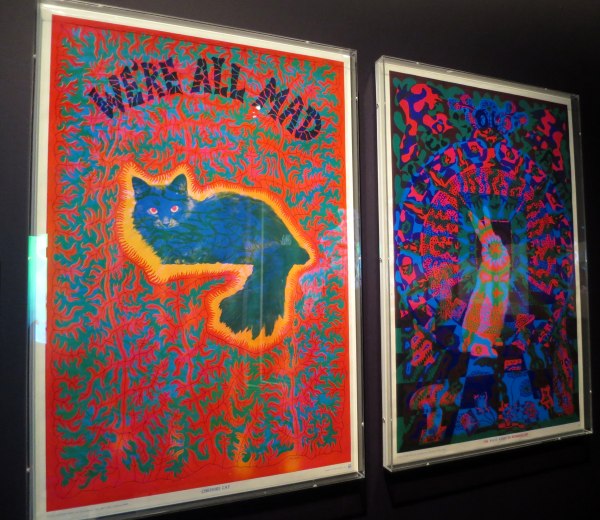
Finally, I managed to see "Curiouser and Curiouser" , the V & A's major exhibition on "Alice" - in particular the evolution of the story from a manuscript to a global phenomenon.
It's been eagerly awaited by Alice fans, but most of the time it was on last year, Britain was in lockdown and the museum was either closed, or had very restricted opening. Even after they extended the show, it was hard to go during the earlier part of this year. Tickets are in high demand, and we had to book here at 12 noon sharp on a Tuesday to be sure of getting in!
Anyone who has watched this "Secrets of the Museum" episode on the BBC will know how much trouble went into creating a Mad Tea Party for the exhibition. Animated film was used to create and change colours and patterns on the table,crockery and tablecloth (which swooshed up and spread out like a banner.)
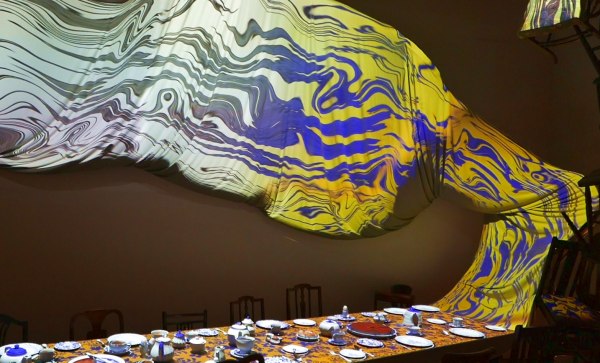
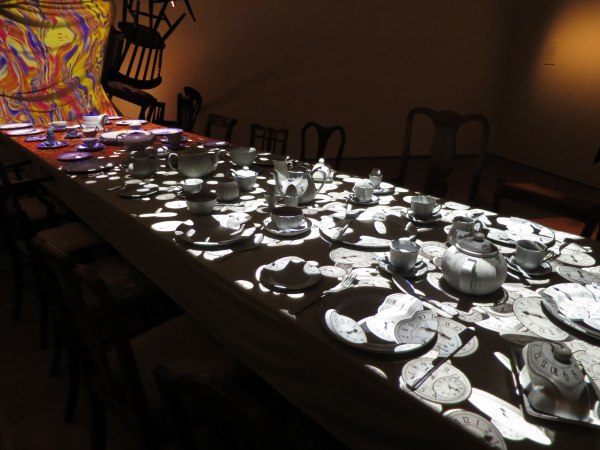
Alongside the animation was a clip from Jonathan Miller's BBC "Alice in Wonderland" film. This film uses many top actors and has a wonderful Gothic atmosphere. Unfortunately, though, Miller demanded a strange performance from the actor who portrayed Alice, in which the poor girl was supposed to represent a blank space in which the viewer could project themselves. It can't have been much fun for her to play. Here's a clip to give you the general atmosphere..
Anyway, when the clip from the film has finished, the teaparty begins to change colour and apparently come to life. It is worth checking on Youtube to see whether anyone has put a film of this on. Certainly many people were filming it when I was there.
The teaparty is one of the big setpieces, but since I'm most interested in Lewis Carroll as a person, I liked the parts which cast light on him and his world. (I noticed that this was also the section that had most people lingering and examining the exhibits carefully.) There are too many to mention but they include a dodo skeleton, and lesser known bits of Carrollania, as well as toys and small objects inspired by the book, such as this little cut out scene spied through a hole in one of the doors. It is, of course, the wondrous garden which Alice glimpses through the tiny door when she is shut in the hallway.
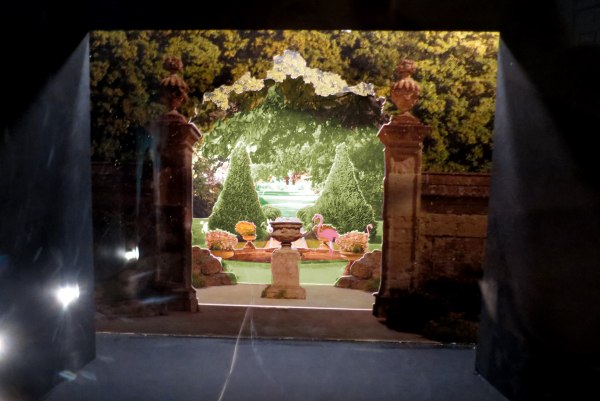
There are also sketches which Carroll apparently did for his own illustrations of the handwritten version of the story which he gave to Alice Liddell herself, and a set of cards for the game of "Ways and Means" which he created in his youth to amuse his many brothers and sisters. I like the card showing the young man representing "The Friend" although the resigned looking cat also makes me smile.
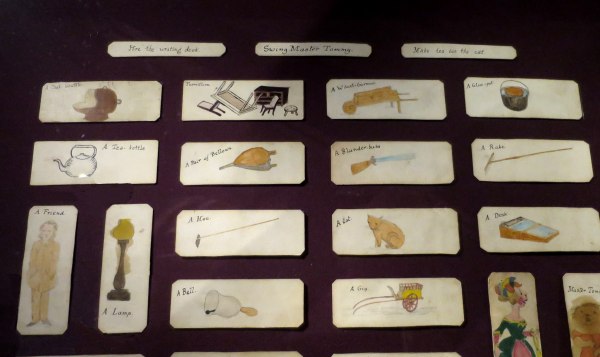
I had hoped that someone might have made up a replica of this game to sell in the gift shop, as I'd have liked to know how it was played, but that wasn't the case.
I also liked a paper panorama of Humpty Dumpty's story which the Dodgson children played with in their youth, and almost certainly would have been in Carroll's mind when creating his own Humpty Dumpty character.
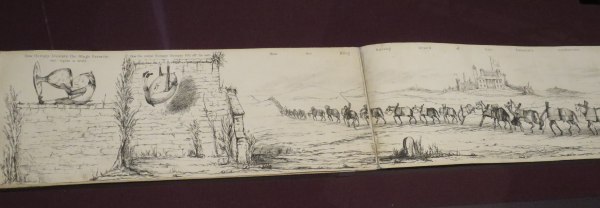
Many of the exhibits showed aspects of the Victorian age which were relevant to "Alice" the book. This huge, expensively made and somewhat grotesque clock (below) could only ever be Victorian, and to me it sums up the period well, right down to the rather moralistic reminder that TEMPUS FUGIT in enamelled mock-medieval lettering.
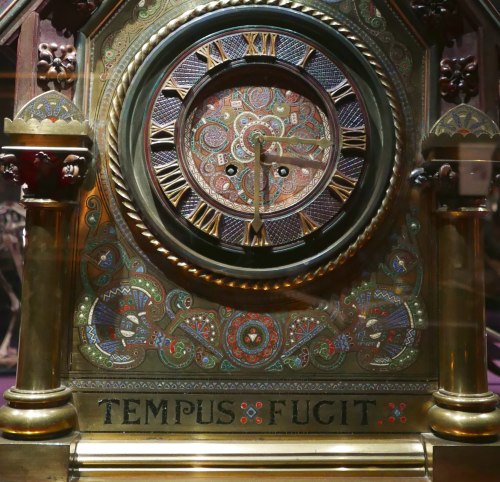
The exhibition catalogue has many pages of pictures from the virtual reality exhibit and many of the gifts in the giftshop also feature the VR steampunk-style artwork, which was created by Kristjana S. Williams
In real life, I'm not sure how many people got to see the VR at the show. There weren't many headsets, and a long and rather crowded queue offered a twenty minute wait for the chance of five minutes playing the Queen at Hearts at croquet. But it looked fun, and well done, and if you have VR at home, you can download it for a very reasonable price.
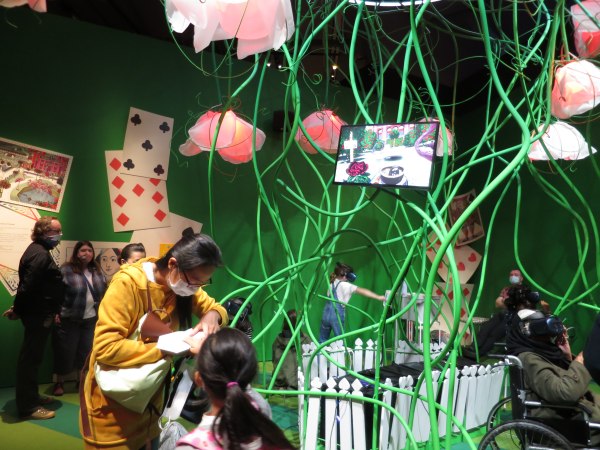
There is a large but rather sparse section on the seaside. I thought the highlight of this was a big animation of bubbling water cascading ceaselessly into a pool, with quotes from the book floating about .... mesmerising.
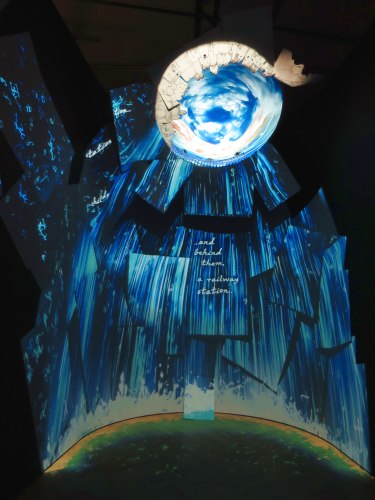
The seaside area contains a section on film and theatrical performances, including several gorgeous vintage film posters and material I hadn't seen before. In fact, even when I went to the Walt Disney Family Museum in San Francisco, I didn't manage to see all Mary Blair's brilliant conceptual sketches for how the Disney "Alice" should look, so it was really good to see them again. They were hard to photograph at the show, so I've linked to some online images.
One of the more baffling Disney-related exhibits was also in this section. It is part of a transcript of a discussion between Walt and Aldous Huxley, who was apparently being considered as an advisor to the film. Aldous Huxley? Why? Could he have been asked because of his experiences with mescalin? It's hard to imagine Walt wanted to make a feature of drug use, but who knows?
But, obviously, hallucinogenics do have their place in the show, including posters from the shortlived but famous American studio "East Totem West" (they did the cat at the top of this post). And, perhaps predictably, there was a film of Jefferson Airplane's "Go Ask Alice."
The exhibit before the exit was one of my favourites. It shows ribbon-like projections constantly twisting and bending into curious shapes - a bit like flowers, a bit like trees
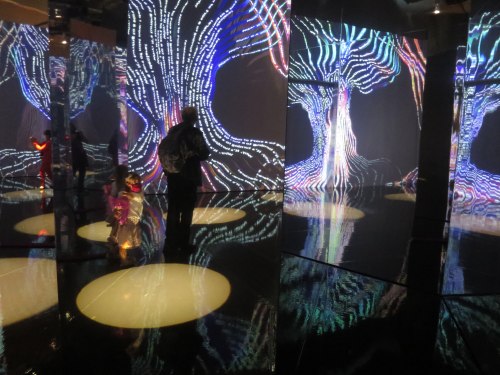
They display some of Alice's more prescient or thought provoking comments, such as "I don't want to be anybody's prisoner - I want to be a Queen." Very much the inner cry of many a Victorian woman, I'd have thought.
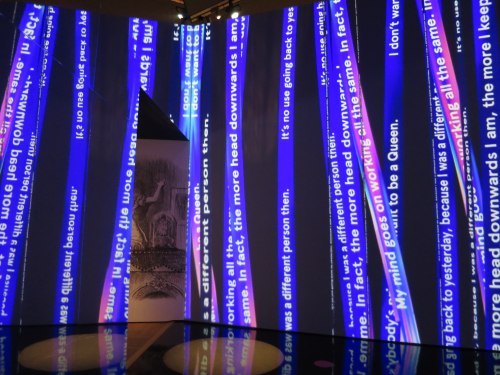
This final exhibition space was full of mirrors and dimly lit, and, in echoes of "Through the Looking Glass" I watched a small golden haired child walking through the room. But as I watched, she seemed to take off in all kinds of different directions as each mirror caught and reflected a different glimpse of her. It seemed a good way in which to end the exhibition.
27 April 2021
Thank you to Tomoko T, who has told me about "Alice in Television Land" from 1986. テレビの国のアリス. I think there are some very creative, strange and original ideas here, including (as far as I can understand it) rather sinister replacement for the Queen of Hearts in Lewis Carroll himself, who wants to photograph Alice's heart.
21 April 2021
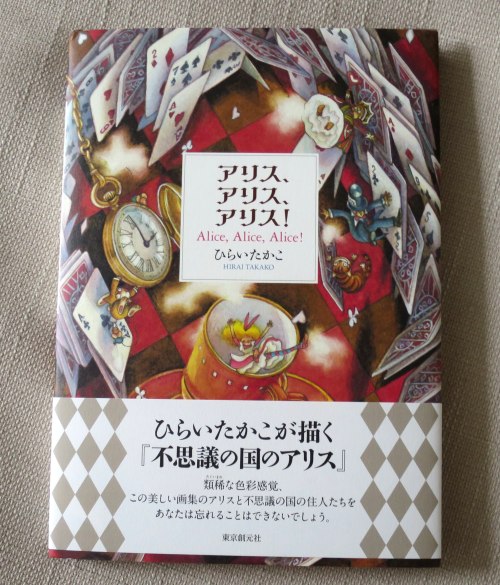
My friend Yoshi sent me another beautiful item created by well known Japanese illustrator Takako Hirai. It's called "Alice Alice Alice" and pulls together some of her cute postcards and other Alice drawings, together with some images that I haven't seen before.
Here, the White Rabbit's House is a 1930s villa growing like a rose on a very tidy rosebush - quite appropriate, as this is the sort of house I always associate with neatly tended gardens of roses.
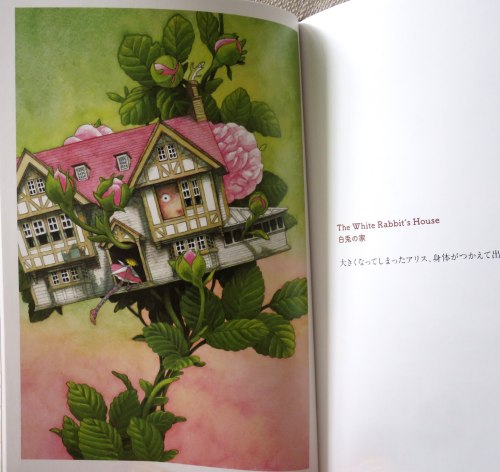
Lewis Carroll's actress friend Isa Bowman said that the most mysterious and thrilling parts of the stories he told to children often included a wood. Here the woodland theme is integrated with the playing cards which fascinate Takako Hirai. The leaves are made of clubs, hearts, spades and diamonds, with a tiny white rabbit tumbling out of the cascade.

Of course I loved the title page with its nice message from Takako to me.
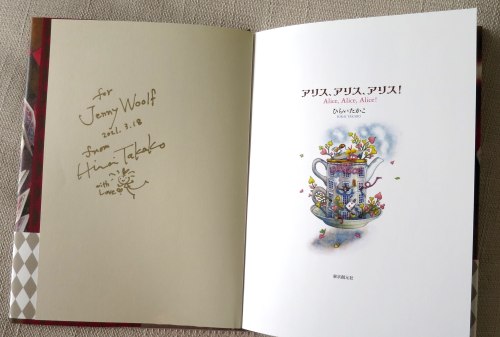
The little teapot opposite was almost my favourite picture of all. The Mad Hatter calls out of the window with a towering plate of buns, the Cheshire Cat sits on the saucer, as the whole thing sails through the air looking as if catastrophe will hit any minute - though you can be totally sure it won't.
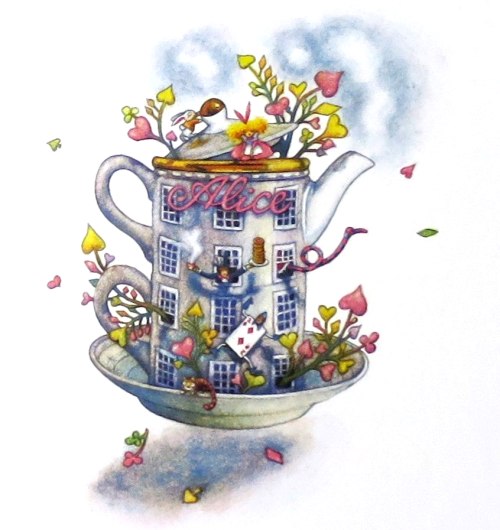
Endpapers are often forgotten in picture books, but here, the endpapers have tiny characters marching about endlessly amidst the magical leaves, in a very Victorian style of design. Maybe one day Takako will create wallpaper like this: I think it has possibilities.
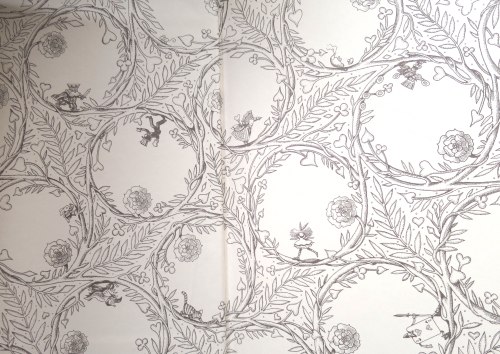
I wish I could show all the many pictures, but, as the Mad Hatter said, "No Room, No Room!" and in any case, the book is so beautifully produced it deserves to be seen in real life. I'm really grateful to Yoshi for this lovely addition to my little collection of illustrated "Alice" books.
 Feed
Feed